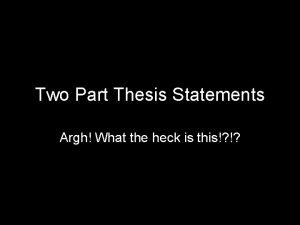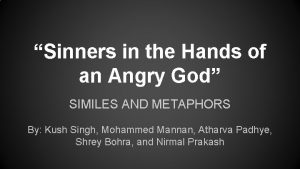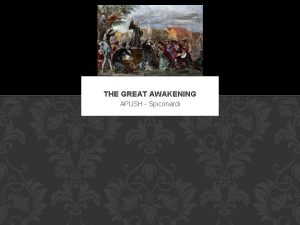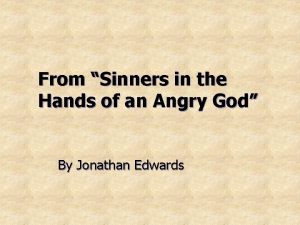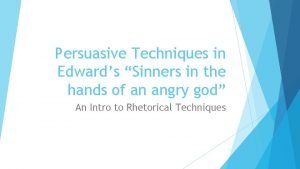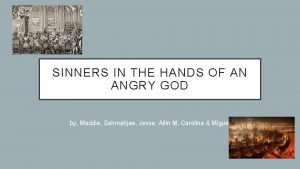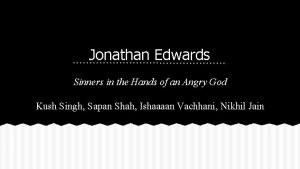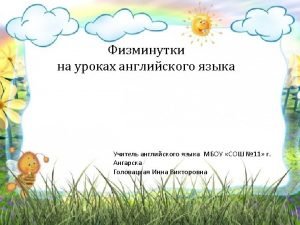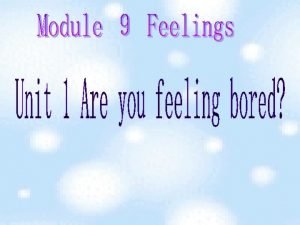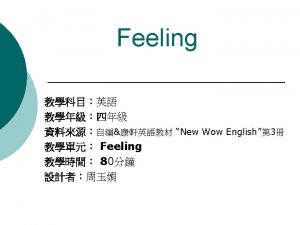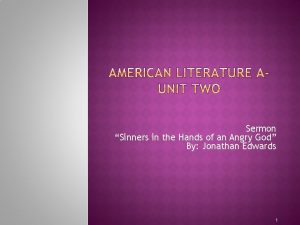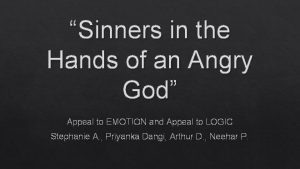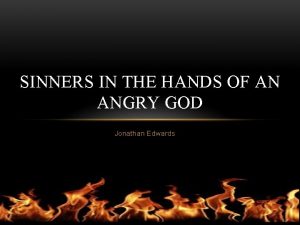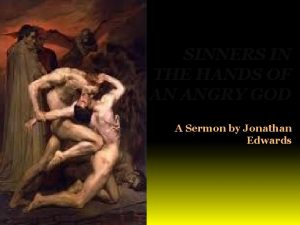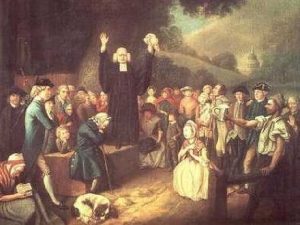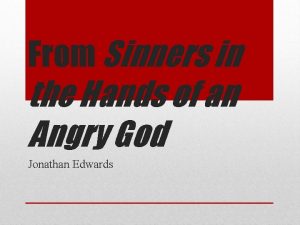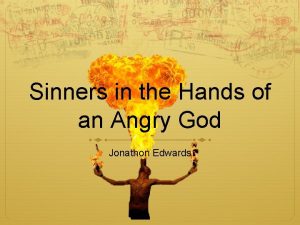from Sinners in the Hands of an Angry













- Slides: 13

from “Sinners in the Hands of an Angry God” Jonathan Edwards (1703 -1758) Literary Terms to Know Handbook of Literary Terms – pages 1169 to 1188 Imagery: The use of language to create a picture or concrete sensation; most uses appeal to the five senses—sight, sound, smell, taste, & touch Figure of Speech: A word or phrase that describes one thing in terms of something else; not meant to be taken literally (simile, metaphor, personification, symbol, etc. ) Simile: Figure of speech that makes a comparison between two seemingly unlike things with the use of a connecting word – like, as, resembles, etc. Metaphor: Figure of speech that makes a comparison between two seemingly unlike things without the use of a connecting word. Parallelism: Parallel structure is the repetition of words or phrases that have similar grammatical structures; often used to create emphasis or enhance argumentation. (Each “group of ideas” have must balance. ) Repetition: Purposefully repeated words or phrases to create a rhythm, reinforce a message, and to enhance a mood or emotional effect.

from “Sinners in the Hands of an Angry God” Jonathan Edwards (1703 -1758) Literary Terms to Know Handbook of Literary Terms – pages 1169 to 1188 Audience: To whom is Edwards’ sermon directed? To whom is he talking? Purpose: What does Edwards hope to accomplish by this sermon? “The use of this awful subject may be for awakening unconverted persons in this congregation. This that you have heard is the case of every one of you that are out of Christ. ” What does Edwards mean that the subject of his sermon is “ for awakening” and who are the “unconverted persons” in the congregation?

from “Sinners in the Hands of an Angry God” Jonathan Edwards (1703 -1758) Literary Terms to Know Handbook of Literary Terms – pages 1169 to 1188 How does Edwards use parallelism (parallel structure) to build a sense of horror among those listening to his sermon? “The devil is waiting for them, hell is gaping for them, the flames gather and flash about them. ” The use of three clauses (the same subject-verb structure), drives home the point like a hammer pounding a nail: Sinners live on the edge of falling into Hell And experiencing its horrors and torments.

from “Sinners in the Hands of an Angry God” Jonathan Edwards (1703 -1758) What does Edwards say is the only thing keeping the sinner from hell and its torture? “… there is nothing between you and hell but the air; it is only the power and mere pleasure of God that holds you up. ”

from “Sinners in the Hands of an Angry God” Jonathan Edwards (1703 -1758) What two creatures does Edwards compare sinners to in the passage in the textbook? Why might Edwards have chosen these two creatures to represent sinners? What characteristics do they share with sinners?

from “Sinners in the Hands of an Angry God” Jonathan Edwards (1703 -1758) How does Edwards say God feels about these “sinners”? The sinners are “loathsome” insects. “His wrath toward you burns like fire; … you are ten times more abominable in His eyes than the most hateful venomous serpent is in ours. ”

from “Sinners in the Hands of an Angry God” Jonathan Edwards (1703 -1758) As Puritans, the speaker and the audience would be familiar with biblical references to a serpent or serpents as evil. The Jewish-Christian Bible describes Satan as appearing in the form of a serpent in the Garden of Eden. John the Baptist addresses unbelievers as a “brood of vipers. ”

from “Sinners in the Hands of an Angry God” Jonathan Edwards (1703 -1758) Literary Terms to Know Handbook of Literary Terms – pages 1169 to 1188 The wrath (anger) of God is described in three main figures of speech. Explain each of the three. 1. “The wrath of God is like great waters that are dammed for the present…the waters are constantly rising…. If God should only withdraw His hand from the floodgate, it would immediately fly open, and the fiery floods of the fierceness and wrath of God would rush forth…” Simile

from “Sinners in the Hands of an Angry God” Jonathan Edwards (1703 -1758) Literary Terms to Know Handbook of Literary Terms – pages 1169 to 1188 The wrath (anger) of God is described in three main figures of speech. Explain each of the three. 2. “The bow of God’s wrath is bent, made ready on the string, your heart, and the arrow and justice bends the arrow at and strains the bow…” Extended metaphor How close is the arrow to being released from the bow?

from “Sinners in the Hands of an Angry God” Jonathan Edwards (1703 -1758) Literary Terms to Know Handbook of Literary Terms – pages 1169 to 1188 The wrath (anger) of God is described in three main figures of speech. Explain each of the three. 3. “The God that holds you over the pit of hell, much as one holds a spider, or some loathsome insect over the fire , … He looks upon you as worthy of nothing else but to be cast into the fire…” Simile How vulnerable is the sinner?

from “Sinners in the Hands of an Angry God” Jonathan Edwards (1703 -1758) Literary Terms to Know Handbook of Literary Terms – pages 1169 to 1188 In addition to the previously discussed items, what sensory images does Edward’s use to make the listeners feel the danger of hell? “…the flames gather and flash about them…” “…that lake of burning brimstone…” “…the dreadful pit of glowing flames…” “…nothing between you and hell but the air…” “Your wickedness makes you as it were heavy as lead…” “…a great furnace of wrath…”

from “Sinners in the Hands of an Angry God” Jonathan Edwards (1703 -1758) Literary Terms to Know Handbook of Literary Terms – pages 1169 to 1188 At the end of Edwards’ sermon, he restates the main idea of his sermon. How would you state it in your own words? He also repetition to increase the emotional effect of his sermon. “You hang by a slender thread, with the flames of divine wrath flashing about, … you have no interest in any mediator, and nothing to keep off the flames of wrath, nothing of your own, nothing that you ever have done, nothing that you can do, to induce God to spare you one moment…” The repetition suggests the urgency of the call to repentance!

from “Sinners in the Hands of an Angry God” Jonathan Edwards (1703 -1758) Puritan Minister Jonathan Edwards saw science and reason as a confirmation of his deeply held spiritual belief in the presence of God in the universe. Edwards’ sermons helped bring about The Great Awakening: Ø waves of conversions … “born again” … the “elect” Ø intensely emotional … mass hysteria Ø publically accused members of lapsing into sin Edwards was named president of the College of New Jersey (Princeton University), died of a smallpox inoculation, and thought of as “the last Puritan”—America was changing.
 Thesis statement for sinners in the hands of an angry god
Thesis statement for sinners in the hands of an angry god Similes for angry
Similes for angry Sinners in the hands of an angry god video
Sinners in the hands of an angry god video Sinners in the hands of an angry god apush
Sinners in the hands of an angry god apush Tactile imagery examples
Tactile imagery examples Sinners in the hands of an angry god main idea
Sinners in the hands of an angry god main idea Alliteration in sinners in the hands of an angry god
Alliteration in sinners in the hands of an angry god Soapstone for sinners in the hands of an angry god
Soapstone for sinners in the hands of an angry god Jonathan edwards apush definition
Jonathan edwards apush definition Sinners in the hand of an angry god summary
Sinners in the hand of an angry god summary Repetition in sinners in the hands of an angry god
Repetition in sinners in the hands of an angry god Hands up utensils down
Hands up utensils down Sad is to happy as bored is to
Sad is to happy as bored is to Happy happy sad sad angry angry
Happy happy sad sad angry angry
